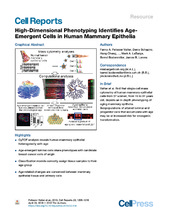High-Dimensional Phenotyping Identifies Age-Emergent Cells in Human Mammary Epithelia
Pelissier, Fanny; Schapiro, Denis; Chang, Hang; Borowsky, Alexander D.; Lee, Jonathan K.; Parvin, Bahram; Stampfer, Martha R.; LaBarge, Mark A.; Bodenmiller, Bernd; Lorens, James B.
Peer reviewed, Journal article
Published version

Åpne
Permanent lenke
https://hdl.handle.net/1956/17728Utgivelsesdato
2018-04Metadata
Vis full innførselSamlinger
Originalversjon
https://doi.org/10.1016/j.celrep.2018.03.114Sammendrag
Aging is associated with tissue-level changes in cellular composition that are correlated with increased susceptibility to disease. Aging human mammary tissue shows skewed progenitor cell potency, resulting in diminished tumor-suppressive cell types and the accumulation of defective epithelial progenitors. Quantitative characterization of these age-emergent human cell subpopulations is lacking, impeding our understanding of the relationship between age and cancer susceptibility. We conducted single-cell resolution proteomic phenotyping of healthy breast epithelia from 57 women, aged 16–91 years, using mass cytometry. Remarkable heterogeneity was quantified within the two mammary epithelial lineages. Population partitioning identified a subset of aberrant basal-like luminal cells that accumulate with age and originate from age-altered progenitors. Quantification of age-emergent phenotypes enabled robust classification of breast tissues by age in healthy women. This high-resolution mapping highlighted specific epithelial subpopulations that change with age in a manner consistent with increased susceptibility to breast cancer.
